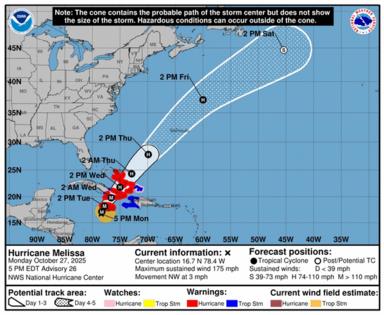'I'm going to lose everything': Jamaica farmers dread approach of Hurricane Melissa
Published in Weather News
There is never a good time for a catastrophic hurricane to hit. But for Junior Ebanks, a farmer on Jamaica’s southern coast, Hurricane Melissa’s timing could not be worse.
“We are just preparing to start planting again for the tourism winter season,” he said from Treasure Beach in St. Elizabeth Parish. “That’s our best growing season, where we get the best possible price for our produce, when all the hotels and our and the Airbnbs are fully booked with tourists from North America, Canada and the U.K.”
Now, instead of preparing his greenhouses to produce 6,000 pounds of Scotch bonnet peppers, along with tomatoes, bell peppers and watermelons over the next 90 days, he’s praying.
“I know a lot of communities are going to be impacted severely, cut off because of the amount of rainfall that is expected,” he said about Hurricane Melissa, which threatens to make landfall Tuesday as a Category 4 or 5 storm along the southern coast. “Some of these are flood-prone areas. I’m expecting, hoping for the best, but I have to be realistic: I’m expecting a lot of devastation.”
Ebanks, 47, was only a kid when the last devastating storm to make a direct hit on Jamaica, Hurricane Gilbert, struck. It was 1988 and Gilbert, a Category 3 storm, made landfall on island’s east coast on a Monday morning in September.
Melissa is forecast to arrive packing even more rain, stronger winds and more destruction.
“The storm seems to be the most devastating that we will ever see in the history of the Jamaican agriculture sector for the southern side of the island,” said Ebanks, who removed the plastics off his greenhouses. “One of the major concerns we have right now is about side erosion and intrusion and the salt water coming inland to make the land less arable over the years to come.”
Gilbert left 49 people dead. There was sheer devastation in its wake, as utility polls and cables blocked roads for miles, and blown-off fences and roofs piled up on roadways. While no one can predict the extent of Melissa’s destruction, the storm is forecast to affect the whole of the island while causing catastrophic and life-threatening flooding and numerous landslides likely starting Monday through Tuesday.
Its catastrophic winds in the eye wall also “have the potential to cause total structural failure, especially in higher elevations,” the National Hurricane Center said. “This will result in extensive infrastructural damage, long-lasting power and communication outages and isolated communities. Life-threatening storm surge and damaging waves are expected along the southern coast through Tuesday.”
Floyd Green, who represents the area and serves as minister of agriculture, said Hurricane Melissa can have “a devastating impact on all of rural Jamaica, and especially our agriculture and fishery.”
The sector suffered $44 million in losses last year, including 232 greenhouses, from Hurricane Beryl, which brushed by the same southern coast where is expected to make a direct hit.
”That was quite significant in terms of setting us back,” Green said. “However, I think all the things that we have been seeing is that Jamaica is building resilience.”
The agricultural sector was just starting to make a comeback from Beryl, he said, when the government began issuing tropical storm warnings and hurricane watches last week as Melissa slowly churned in the Caribbean, threatening not only Jamaica but Haiti and the Dominican Republic.
For years now, Jamaica has been investing in its agriculture sector, especially in the use of greenhouses and in the linkages between farmers and hoteliers. And that has been paying dividends both for the country and farmers like Ebanks, who says he lost almost $625,000 in last year’s storm.
“Outside of weather events, we are self-sufficient … in things like lettuce, cabbage, tomatoes, and we’re self-sufficient in poultry and in eggs,” Green said. “But once there’s a major weather event, we know that it does have a significant impact on our vegetables. We saw that with Beryl; it had a significant impact on our egg production because of the loss of birds.
“We have, over the last decade, achieved some levels of self-sufficiency in a number of areas, but these weather events are the greatest threat to that,” he added. “Unfortunately, the projections for Melissa, is that it will come on land in the most productive agricultural belt, which happens to be my constituency.”
Melissa is also arriving during what is traditionally the time of year that Caribbean farmers use to get their crops in the field in time for the Christmas season. “Farmers, fishers, they look forward to the uptick in demand that comes with Christmas,” Green said. “It’s just a bad time in the farming cycle.”
Green said his ministry has been in communication with farmers, fishermen and others throughout the country, urging Jamaicans to secure livestock, boats and others investments as well as themselves.
“We are seeing greater awareness, greater take-up, and we now use the technology so we have our WhatsApp groups for our fishers. We had put in a DHF radio system that we can communicate with them early. So I think those advances are helping with preparing for this,” he said. “With that said, the challenges are a creating a certain level of despair that besets farmers.”
Last year, Hurricane Beryl flattened all the greenhouse in the Treasure Beach community, said Ebanks, who on Monday was at home bunkered down with four of his kids. He was only able to get his greenhouses mounted back up four months ago, he said, after securing the financing after taking the hit from Beryl’s damaging winds and rains. He doesn’t even want to think about Melissa’s potential impact.
“I’m just praying. I’m saying to myself, ‘Whoa, this is déjà vu, and I’m going to lose everything again,” Ebanks said, “Every single thing. Because with the Category 5 hurricane coming with all that water, rain, I mean, I can’t even imagine what it’s going to be like.”
While Melissa is threatening to make a direct hit on Jamaica, other nearby islands are also facing catastrophic floods and possible landslides. This includes the Dominican Republic and Haiti, which share the island of Hispaniola. Both nations have already seen flooding from the storm even before it intensified to a hurricane, and together have logged four deaths.
After reaching Jamaica, Melissa is forecast to remain a major hurricane when it reaches Cuba. Hurricane conditions, life-threatening storm surge and heavy rainfall are also possible Wednesday in the southern Bahamas and the Turks and Caicos Islands.
Elizabeth Riley, the head of the Caribbean Disaster Emergency Management Agency, the response arm for Caribbean Community governments, says the agency stands ready to respond to member nations requests.
“Of course, our best wishes and our thoughts and prayers are with the government of Jamaica at this time,” she said. “Our team has been on the ground since Friday, supporting them not only in terms of technical advice in the National Emergency Operations Center for the preparedness planning, but also preparation for the response.”
Her agency has deployed a telecommunication specialist to Jamaica, Riley said, ahead of the impact to support the Office of Disaster Preparedness and Emergency Management to restore telecommunications for parish disaster emergency committees.
This is an important add, she said, noting that in past communities like Treasure Beach were cut off after a storm.
“We continue to hope for the best, but we are putting all the resources in the regional mechanism on standby,” Riley said.
For days, Prime Minister Andrew Holness and cabinet ministers have been warning Jamaicans that the threat is real, and they need to batten down. In addition to devastation to the agricultural sector, the country risks seeing disruptions to health care services; interruption of supply chains, and possible injuries or deaths from wind damage, debris and falling trees.
All public hospitals have entered emergency mode, meaning they remain open, though outpatient services and elective surgeries have been suspended. There are 116 priority facilities, including 25 hospitals, on the island, the health ministry said.
Christopher Tufton, the country’s health minister, says his agency is monitoring developments on an hourly basis. He has been traveling the island to evaluate hospitals, checking on availability and beds.
Tufton, also a former agriculture minister, told the Herald “The staff are on standby. They are refreshed; meals are in place along with basic medications.”
_____
©2025 Miami Herald. Visit at miamiherald.com. Distributed by Tribune Content Agency, LLC.







Comments